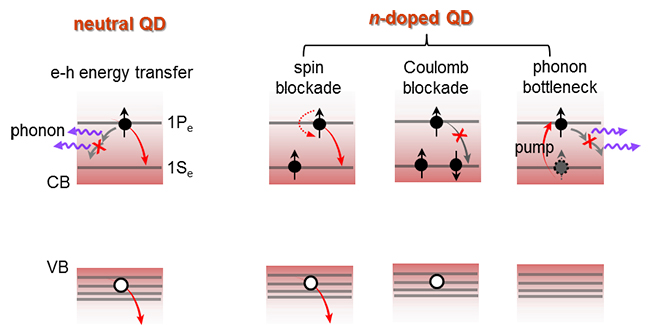In conventional solar cells, the excessive energy of carriers above the band gap of a semiconductor is lost in the form of heat due to rapid cooling of hot carriers via emission of phonons. This is a major reason for Shockley–Queisser limit of solar cell efficiency.
Extraction the hot carrier to selective contacts has the potential to boost power conversion efficiency of solar cells to as high as 66%. The challenge in efficient hot carrier extraction is that intraband cooling of hot carriers usually occurs in a sub-picosecond timescale.
A research group led by Prof. WU Kaifeng from the Dalian Institute of Chemical Physics (DICP) of the Chinese Academy of Sciences (CAS) recently observed hot electrons as long-lived as more than 300 picoseconds in electron-doped (n-doped) colloidal CdSe quantum dots.
This study was published in Nat. Commun. on Jan. 22.

Carrier-carrier, carrier-phonon and spin-spin interactions in doped quantum dots result in long-lived hot electrons (Image by WANG Junhui)
For lightly-doped dots they observed a slow 1Pe hot electron relaxation (~10 picosecond) resulting from a Pauli spin blockade of the preoccupying 1Se electron. For heavily-doped dots, a large number of electrons residing in the surface states introduced picosecond Auger recombination which annihilated the valance band hole. Thus the researchers could observe 300-picosecond-long hot electrons as a manifestation of a phonon bottleneck effect. This decreased the hot electron energy loss rate to a level of sub-meV per picosecond from a usual level of 1 eV per picosecond.
These results offered exciting opportunities of hot electron harvesting by exploiting carrier-carrier, carrier-phonon and spin-spin interactions in doped quantum dots.
"The observation of long-lived hot electrons in QDs light on the utilization of long-lived hot electrons for high-efficiency photovoltaics and photocatalysis," said Prof. WU.
This work was supported by the Ministry of Science and Technology of China, the Chinese Academy of Sciences, the National Natural Science Foundation of China and the LiaoNing Revitalization Talents Program. (Text by WANG Junhui)